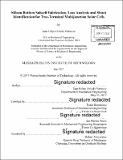Silicon bottom subcell fabrication, loss analysis and shunt identification for two-terminal multijunction solar cells
Author(s)
Oviedo Perhavec, Juan Felipe
DownloadFull printable version (9.789Mb)
Other Contributors
Massachusetts Institute of Technology. Department of Mechanical Engineering.
Advisor
Tonio Buonassisi and Ian Marius Peters.
Terms of use
Metadata
Show full item recordAbstract
Two-terminal multijunction solar cells are a promising technology to surpass the energy-conversion efficiency of commercial single junction devices. Multijunction solar cells that integrate silicon bottom subcells could allow cost-effective efficiency enhancements and further growth in the worldwide installed photovoltaic capacity. However, the fabrication and characterization of multijunction devices is more complex than the standard single junction case, due to optical, electrical and architecture constraints. In this context, this thesis proposes and tests methods for fabrication and characterization of two-terminal multijunction devices, with special emphasis in the bottom silicon subcells. A low-capex, local area back-surface field, silicon cell is adapted for operation in a two-terminal perovskite-silicon tandem device. A contactless voltage loss analysis methodology is developed, and used to optimize the tunnel junction of the device. Finally, a general methodology to identify the shunted cells in two-terminal tandem devices is developed and validated in GaAs/GaAs tandem device. These characterization methodologies allow an adequate diagnosis of quality issues in multijunction solar cells, and provide useful tools for future efficiency improvements.
Description
Thesis: S.M., Massachusetts Institute of Technology, Department of Mechanical Engineering, 2017. Cataloged from PDF version of thesis. Includes bibliographical references (pages 75-82).
Date issued
2017Department
Massachusetts Institute of Technology. Department of Mechanical EngineeringPublisher
Massachusetts Institute of Technology
Keywords
Mechanical Engineering.